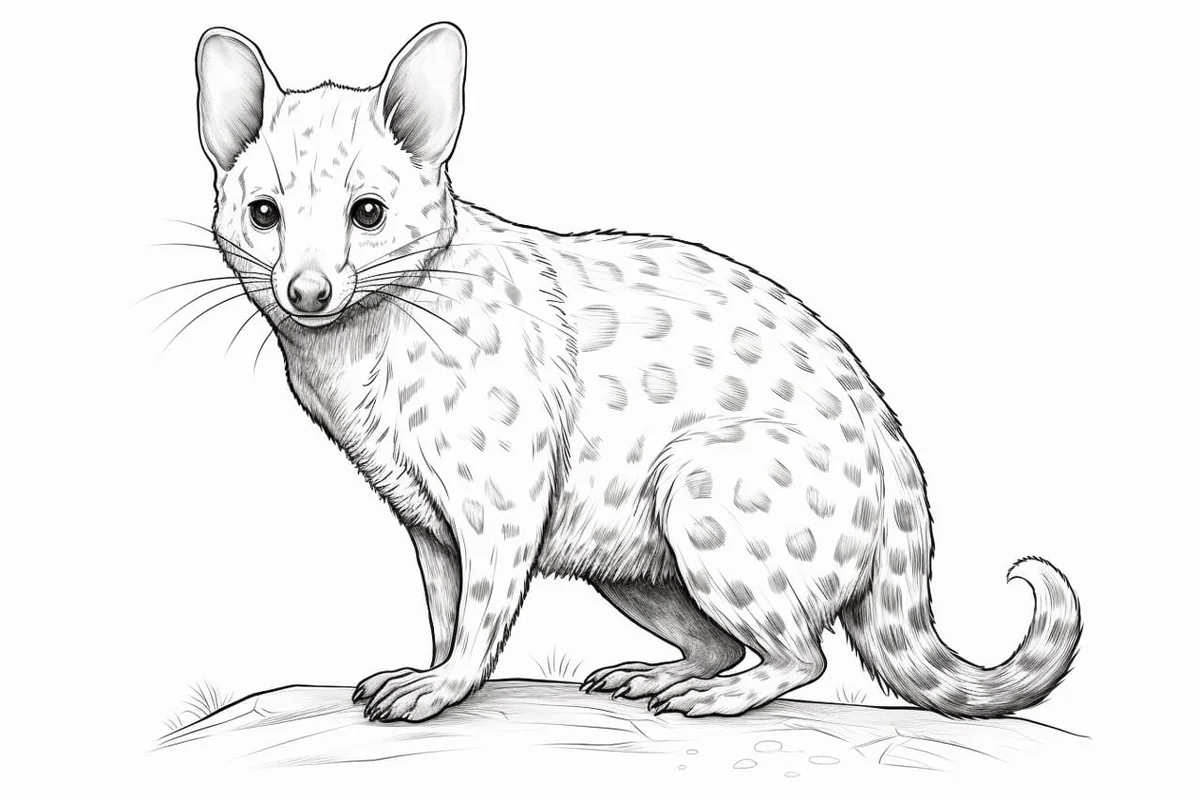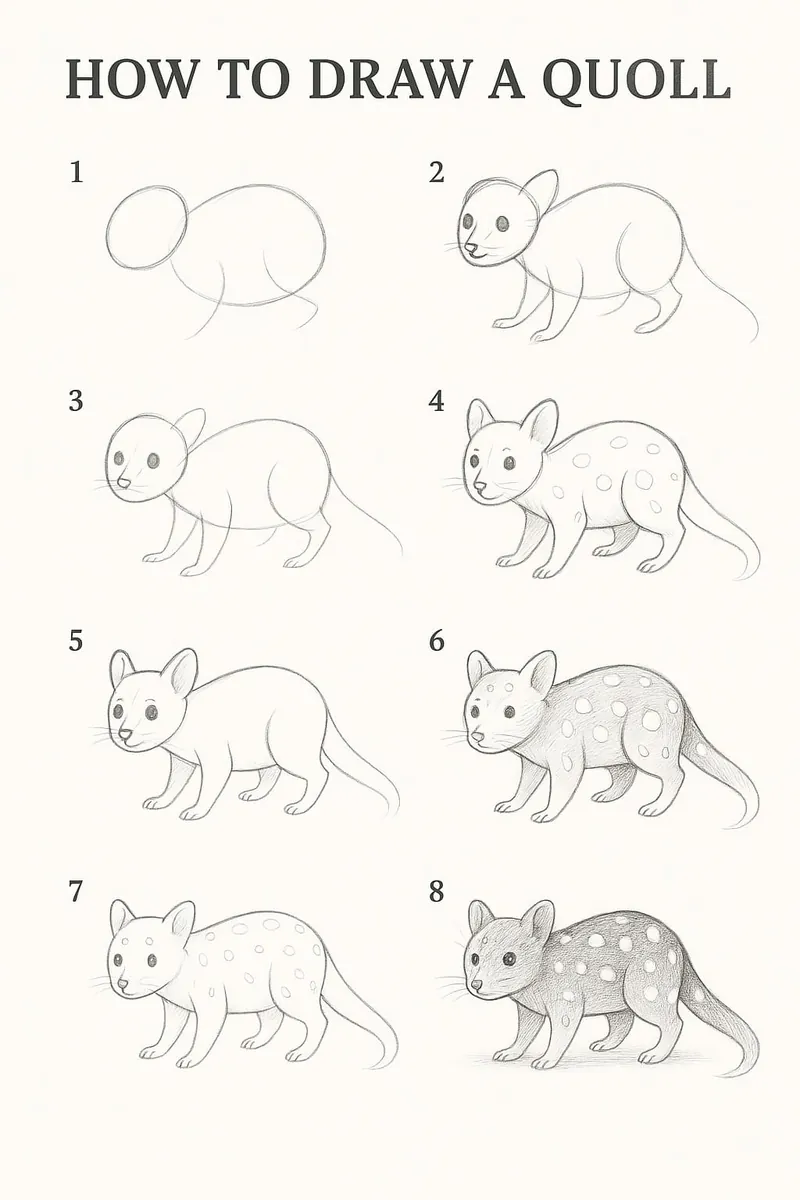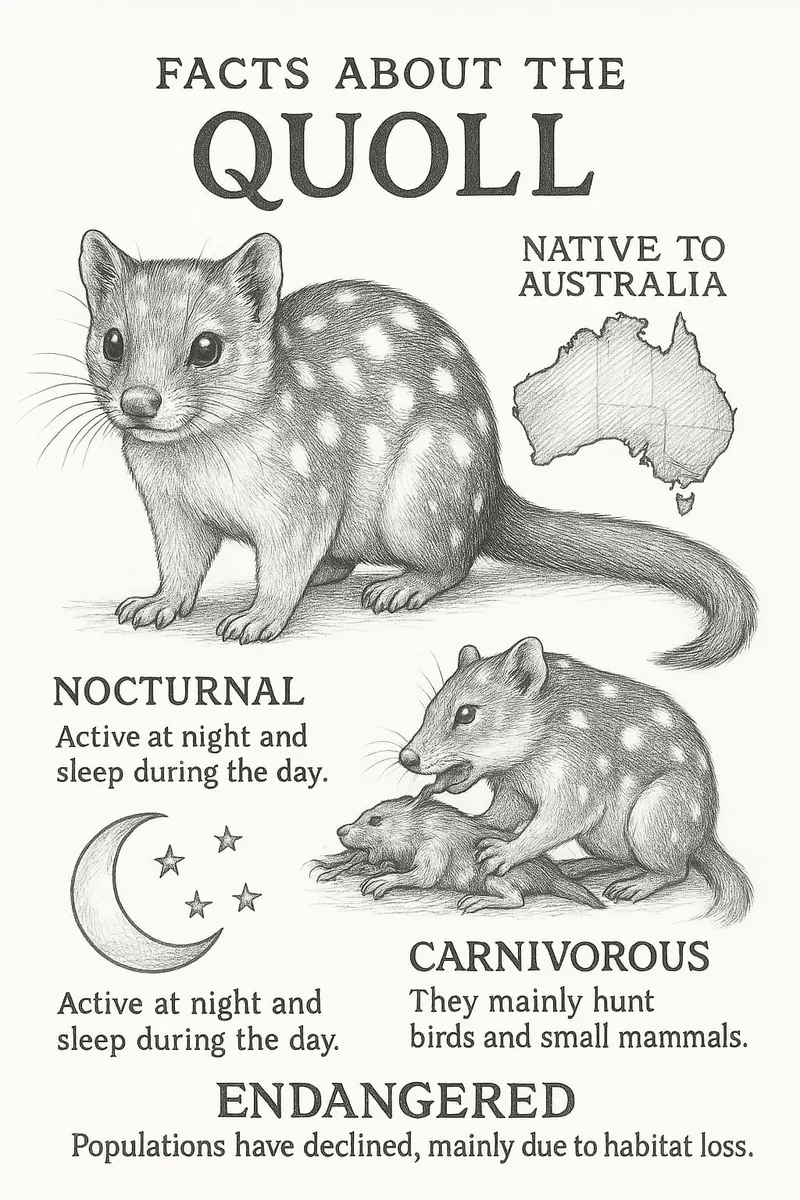How to Draw a Quoll in 8 Easy Steps
In this article, we explore the art of drawing the fascinating Quoll. Learn how to capture the unique features and intricate patterns of this elusive marsupial

Materials You'll Need
- Drawing paper
- Pencil (HB or 2B)
- Eraser
- Colored pencils
- Markers
- Blending stump
- Watercolor paints

Drawing can be an incredibly rewarding form of expression, and what better way to hone your skills than by learning to depict an enchanting creature like the Quoll? These charming marsupials, native to Australia and New Guinea, are not only visually striking—thanks to their distinctive spotted fur and long, elegant tails—but also rich in character and intrigue. Whether you're an aspiring artist just starting your journey or a seasoned illustrator looking to diversify your portfolio, learning how to draw a Quoll can be a fun and fulfilling challenge.
In this instructional guide, we will delve into the unique features that make the Quoll such a captivating subject for illustration. You'll discover how to render the intricate textures of its fur, convey its lively expressions, and accurately portray its proportions. We'll provide you with detailed, step-by-step instructions, enabling you to transform a blank page into a lifelike depiction of this delightful creature. So, gather your materials, and let your creativity take flight as we embark on this artistic journey into the world of Quolls!
Prepare for an adventure that not only enhances your drawing skills but also deepens your appreciation for these fascinating animals. Each stroke of your pencil will bring you closer to mastering the art of wildlife illustration, all while reminding you of the beauty and uniqueness of the Quoll. Get ready to unleash your artistic potential!



Materials Required
To draw a Quoll, you will need the following materials:
-
Pencil: for sketching and outlining the Quoll's features.
-
Paper: to draw the Quoll on.
-
Eraser: for correcting mistakes and refining details.
-
Colored pencils or markers: to add color to your Quoll drawing.
-
Reference image: to help you accurately depict the Quoll's appearance and features.
-
Sharpener: to keep your pencils sharp for detailed drawing.
-
Blending tools: such as blending stumps or cotton swabs, to blend colors and create smooth transitions.
-
Optional: pastels or watercolors for a different artistic effect.:
How to Draw a Quoll: a Step-by-step Guide
Step 1: Start with the Basic Shapes
-
Draw an oval for the head, tilted slightly to the side.
-
Add a larger, rounded shape for the body, positioned behind and lower than the head.
-
Sketch a soft line connecting them — this will guide the neck.
Step 2: Map Out the Legs and Tail
-
Use simple lines or ovals to place the front and back legs — remember quolls have stocky limbs.
-
Add a long, curved line extending from the body for the tail — it's thick at the base and tapers to a point.
Step 3: Add Facial Guidelines
-
Lightly draw a vertical line down the head to center the face.
-
Cross it with a horizontal line for eye placement.
-
Sketch two big, round eyes, a small nose at the tip, and a slight curve for the mouth.
Step 4: Shape the Ears and Paws
-
Quolls have big, rounded ears — draw them on top of the head like wide C-shapes.
-
Begin shaping the paws, adding little toes (four on the front, five on the back).
Step 5: Outline the Fur
-
Go over your shapes with smoother, confident lines.
-
Add gentle curves along the body for the fur texture.
-
Draw the tail bushy but streamlined.
Step 6: Add the Spots!
-
Draw white spots along the back, tail, and legs — quolls are known for these!
-
Vary the size and keep them randomly placed for a natural look.
Step 7: Shade with Pencil
-
Use light pencil strokes to add depth under the chin, belly, and legs.
-
Shade the eyes to make them glossy — leave a little white for highlights.
-
Darken areas like the nose, pupils, and shadowed parts of the body.
Step 8: Final Touches
-
Add a few whiskers and texture details to the ears and tail.
-
Erase any extra guide lines.
-
Soften or darken your shading as needed.

Tip: To capture the essence of a Quoll effectively, focus on using a variety of pencil grades to create depth and texture in your drawing. Start with a light pencil, like 2H, for the initial sketch to outline the basic shapes and proportions of the Quoll, ensuring your lines are soft and easily erasable. As you build up the details, switch to softer pencils, such as HB or 2B, to add shading and dimension to the fur, paying special attention to the direction of the fur growth for a more realistic effect. For the distinct spots, use a fine-tipped pen or a darker pencil to carefully define their edges, making sure to vary the size and shape of the spots to mimic the natural irregularities found in real Quolls. Finally, don't forget to step back occasionally and assess your work from a distance; this will help you see the overall composition and ensure you've captured the Quoll's lively character!
Conclusion
Beautiful work capturing the charm of the quoll! Your careful attention to detail and thoughtful shading have brought this unique creature to life. Keep experimenting with new techniques and subjects — your creativity is just getting started. Stay curious, stay inspired, and keep those pencils moving. You're doing great!
Fun Facts About Quolls
-
Quolls are carnivorous marsupials native to Australia and New Guinea.
-
There are four species of quolls: the Northern Quoll, Eastern Quoll, Western Quoll, and Spotted-tailed Quoll.
-
Quolls are known for their spotted fur, which helps them blend into their forest habitats.
-
They are skilled climbers and are known to hunt in trees as well as on the ground.
-
Quolls are primarily nocturnal, meaning they are most active at night.
-
Female quolls have a unique reproductive system where they have a bifurcated (split) reproductive tract, allowing them to mate with multiple males and potentially produce offspring from different fathers in the same litter.
-
Quolls have a diverse diet that includes insects, small mammals, birds, reptiles, and even fruits.
-
They are solitary animals and typically only come together to mate.
-
Quolls have a strong musky odor, which they use for communication and to mark their territories.
-
Unfortunately, all four species of quolls are currently listed as threatened or endangered due to habitat loss, introduced predators, and disease.

Suggestions for Scenes and Settings for Quoll Drawings
Of course! Here are some specific suggestions for scenes and settings for drawings of Quolls:
-
Quolls in their natural habitat: Consider drawing quolls in a lush, dense forest setting with plenty of trees, rocks, and undergrowth. This will showcase their natural environment and behavior.
-
Quolls at night: Capture the elusive nature of quolls by drawing them in the darkness of night, perhaps under a starry sky or with the glow of the moon highlighting their fur.
-
Quolls in a rainforest: Show quolls navigating through a vibrant, tropical rainforest with colorful foliage, cascading waterfalls, and exotic wildlife in the background.
-
Quolls hunting for food: Illustrate quolls in action as they hunt for insects, small mammals, or reptiles. You could depict them pouncing on prey or stealthily stalking their target.
-
Quolls in an urban setting: Explore the interaction between quolls and human environments by drawing them in a cityscape or suburban neighborhood. This could highlight the challenges they face living in close proximity to humans.
-
Quolls in a family group: Show the social side of quolls by drawing a family group interacting with each other - perhaps playing, grooming, or caring for their young.
-
Quolls in a conservation setting: Highlight the importance of quoll conservation by depicting them in a protected area, such as a wildlife sanctuary or national park. This could raise awareness about the threats they face and the efforts being made to protect them.